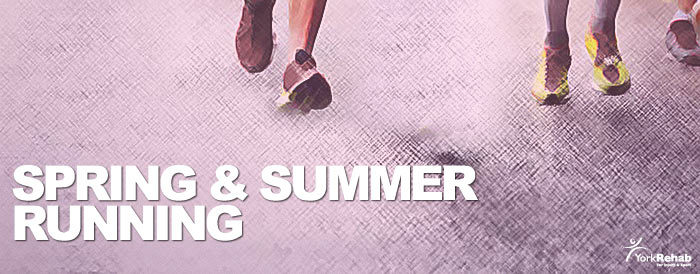905.715.7201
jogging
Spring/Summer Running
Spring is here –time to follow-up on all of your New Year’s resolutions and dust off your sneakers!
Before we know it, summer will be upon us and the heat we’ve be yearning for all winter will finally be here.
Be sure to prepare for the summer conditions to ensure you succeed with all your summer running goals.
PRE-RUN:
- Monitor the weather forecast. Note the UV index to reduce your risk of harmful overexposure to radiation. In addition, pay attention to the Humidex as it incorporates both humidity and temperature. As a general rule with both indexes, the higher the number, the greater the need to exercise caution.
- Dress appropriately. “Cotton is rotten”, or so they say. Technical or quick-dry clothing are best, as they are lightweight, offer warmth without bulk and have effective properties to remove moisture away from the skin. Use the “Rule of 10” as a guide in choosing those layers -dress for temperatures 10 degrees warmer than that listed. To avoid overheating, you should feel cool as you head outdoors –you’ll feel warm within 10-15 minutes after starting of your run. Don’t forget important accessories such as a running hat or visor, in addition to sport sunglasses.
- Protect your feet. Check for tears and/or wear patterns on your shoes. The cushioning foam becomes compressed and/or breaks down after continued impact, resulting in reduced shock absorption. If you can’t remember the last time you purchased a new pair of shoes though, chances are, you need to go shopping! Running shoes should be replaced approximately every 800 kms.
- Run safe. Run with a buddy or, if you plan to run alone, notify others of your route and your expected departure and return times. Run in a series of loops and have a designated turn-around point should you need to cut your run short or seek shelter. Always run with identification and carry a cell phone in the event of an emergency.
MID-RUN:
- Monitor for early signs of heatstroke. This is the most serious heat-related illness. Prolonged exposure to high temperatures results in an elevated core temperature. This then causes a series of symptoms ranging from nausea, seizures, confusion, disorientation and sometimes loss of consciousness. In extreme cases, it can even cause death.
- Stay hydrated. With higher temperatures, your sweat production will increase. The evaporation of water from the skin by increased body heat is used as a means of temperature regulation. With increased loss of fluid, your risk for dehydration increases. Carry a water belt with you to replenish fluids lost –avoid extreme thirst!
POST-RUN:
- Perform a cool-down. Low intensity activity, promoting functional range of movement is recommended.
Should you require information and recommendations for exercising safely with a variety of health conditions consult a member of our Physiotherapy Team at YRA.






